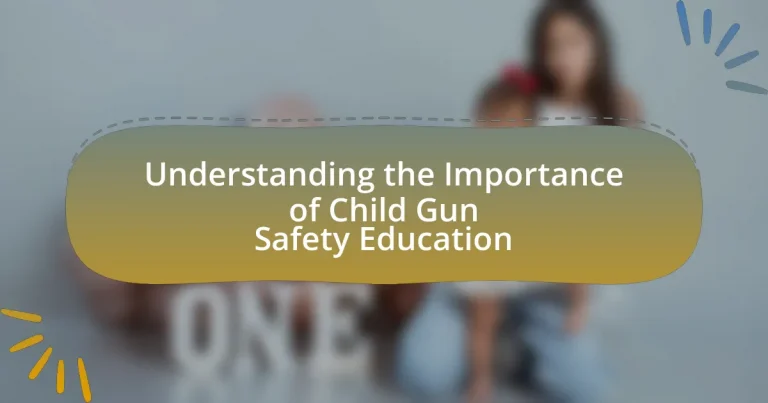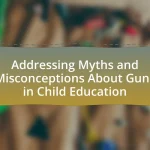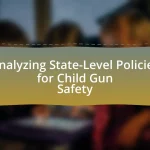Child Gun Safety Education is a crucial program aimed at teaching children the safe handling and storage of firearms to prevent accidental shootings and promote responsible behavior. With nearly 400 children dying from unintentional firearm injuries annually in the United States, the need for effective education is evident. Key components of this education include understanding firearm safety rules, recognizing the dangers of firearms, and knowing how to respond if a child encounters a gun. The article discusses the statistics highlighting the necessity of such education, the role of parents and educators, and the long-term benefits of instilling gun safety awareness in children to create safer environments.
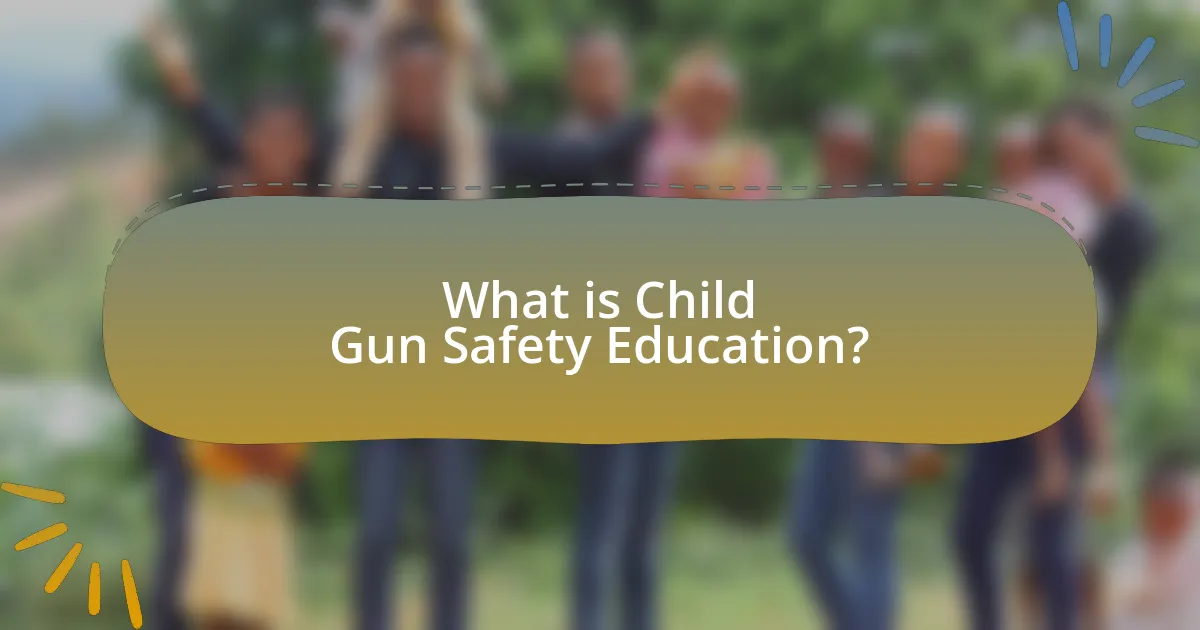
What is Child Gun Safety Education?
Child Gun Safety Education is a program designed to teach children about the safe handling and storage of firearms. This education aims to reduce the risk of accidental shootings and promote responsible behavior around guns. According to the National Safety Council, proper education can significantly decrease the likelihood of firearm-related accidents among children, emphasizing the importance of teaching children to recognize firearms and understand the dangers associated with them.
Why is Child Gun Safety Education necessary?
Child gun safety education is necessary to prevent accidental shootings and promote responsible firearm handling among children. Statistics indicate that in the United States, nearly 400 children die from unintentional firearm injuries each year, highlighting the critical need for education. Teaching children about gun safety can significantly reduce these incidents by instilling awareness and caution regarding firearms. Programs that educate children on the importance of not touching guns and seeking adult help when encountering one have been shown to decrease the likelihood of accidents, reinforcing the necessity of such education in safeguarding lives.
What statistics highlight the need for Child Gun Safety Education?
In the United States, approximately 4.6 million children live in homes with at least one loaded and unlocked firearm, highlighting the urgent need for Child Gun Safety Education. Research indicates that unintentional shootings involving children occur at an alarming rate, with the Centers for Disease Control and Prevention reporting that firearms are the second leading cause of death for children aged 1 to 19. Furthermore, a study published in the journal “Pediatrics” found that nearly 1 in 3 children aged 5 to 14 years reported having handled a gun, often without parental knowledge. These statistics underscore the critical importance of educating children about gun safety to prevent tragic accidents and save lives.
How do accidents involving children and firearms occur?
Accidents involving children and firearms occur primarily due to unsupervised access to loaded guns. Research indicates that a significant number of these incidents happen when children find firearms that are not securely stored, leading to unintentional discharges. According to the Centers for Disease Control and Prevention (CDC), in 2019, there were over 300 unintentional firearm deaths among children in the United States, highlighting the critical need for proper gun storage and safety education. Furthermore, studies show that children often do not understand the dangers associated with firearms, which increases the likelihood of accidents when they encounter guns.
What are the key components of Child Gun Safety Education?
The key components of Child Gun Safety Education include understanding firearm safety rules, recognizing the dangers of firearms, and knowing how to respond if a child encounters a gun. Firearm safety rules typically encompass the principles of treating every gun as if it is loaded, keeping the gun pointed in a safe direction, and keeping fingers off the trigger until ready to shoot. Recognizing the dangers involves educating children about the potential risks associated with firearms and the importance of not touching them. Additionally, children should be taught to seek help from an adult if they find a gun, emphasizing the importance of communication and safety. These components are supported by research indicating that proper education can significantly reduce the risk of accidental shootings among children.
What topics should be covered in Child Gun Safety Education programs?
Child Gun Safety Education programs should cover the following topics: safe storage practices, recognizing and avoiding firearms, emergency response actions, and the importance of communication with adults about gun safety. Safe storage practices emphasize keeping firearms locked and inaccessible to children, which is crucial as studies show that 73% of children know where their parents’ guns are stored. Recognizing and avoiding firearms teaches children to identify guns and understand the dangers associated with them. Emergency response actions instruct children on what to do if they encounter a firearm, including not touching it and seeking help from an adult. Lastly, fostering open communication with adults about gun safety encourages children to speak up if they feel unsafe, reinforcing the idea that safety is a shared responsibility.
How can parents effectively communicate gun safety to their children?
Parents can effectively communicate gun safety to their children by engaging in open discussions about firearms, emphasizing the importance of treating every gun as if it is loaded. This approach fosters a culture of safety and awareness. Parents should use age-appropriate language and scenarios to explain the dangers associated with guns, ensuring that children understand the potential risks. Additionally, demonstrating safe handling practices, such as keeping guns locked away and out of reach, reinforces the message. Research indicates that children who receive proper education about gun safety are less likely to engage in risky behaviors, highlighting the effectiveness of proactive communication.
What age-appropriate strategies exist for teaching gun safety?
Age-appropriate strategies for teaching gun safety include using age-specific discussions, interactive activities, and role-playing scenarios. For young children, simple concepts such as “stop, don’t touch, run away, and tell a grown-up” can be introduced through storytelling and games. For older children, discussions can include the responsibilities of gun ownership and the importance of safe storage practices. Engaging in role-playing scenarios allows children to practice what to do if they encounter a firearm, reinforcing their understanding of safety protocols. Research indicates that early education on gun safety significantly reduces the risk of accidental shootings among children, highlighting the effectiveness of these strategies.
How can gun safety education be tailored for different age groups?
Gun safety education can be tailored for different age groups by adjusting the complexity of the information and the methods of delivery. For young children, education should focus on basic concepts such as recognizing firearms, understanding that guns are not toys, and promoting the importance of telling an adult if they encounter a gun. This can be achieved through engaging storytelling and interactive activities that emphasize safety.
For pre-teens, the curriculum can introduce more detailed discussions about the risks associated with firearms, safe handling practices, and the importance of following rules. Role-playing scenarios can be effective in helping them understand how to respond in various situations involving guns.
Teenagers require a more comprehensive approach that includes discussions about the legal implications of gun ownership, the responsibilities that come with it, and the potential consequences of unsafe behavior. Incorporating real-life case studies and statistics about gun-related incidents can enhance their understanding and encourage responsible attitudes toward firearms.
Research indicates that age-appropriate education significantly reduces the likelihood of accidental shootings and promotes a culture of safety. For instance, a study published in the Journal of Pediatrics found that children who received structured gun safety education were less likely to engage in risky behaviors around firearms.
What role do interactive activities play in teaching gun safety?
Interactive activities play a crucial role in teaching gun safety by engaging learners in hands-on experiences that reinforce safety concepts. These activities, such as simulations and role-playing scenarios, allow participants to practice safe handling and decision-making in a controlled environment. Research indicates that experiential learning significantly enhances retention of safety protocols; for instance, a study published in the Journal of Safety Research found that participants who engaged in interactive training retained 70% of the information compared to 20% retention from traditional lectures. This evidence underscores the effectiveness of interactive methods in instilling critical gun safety knowledge and behaviors.
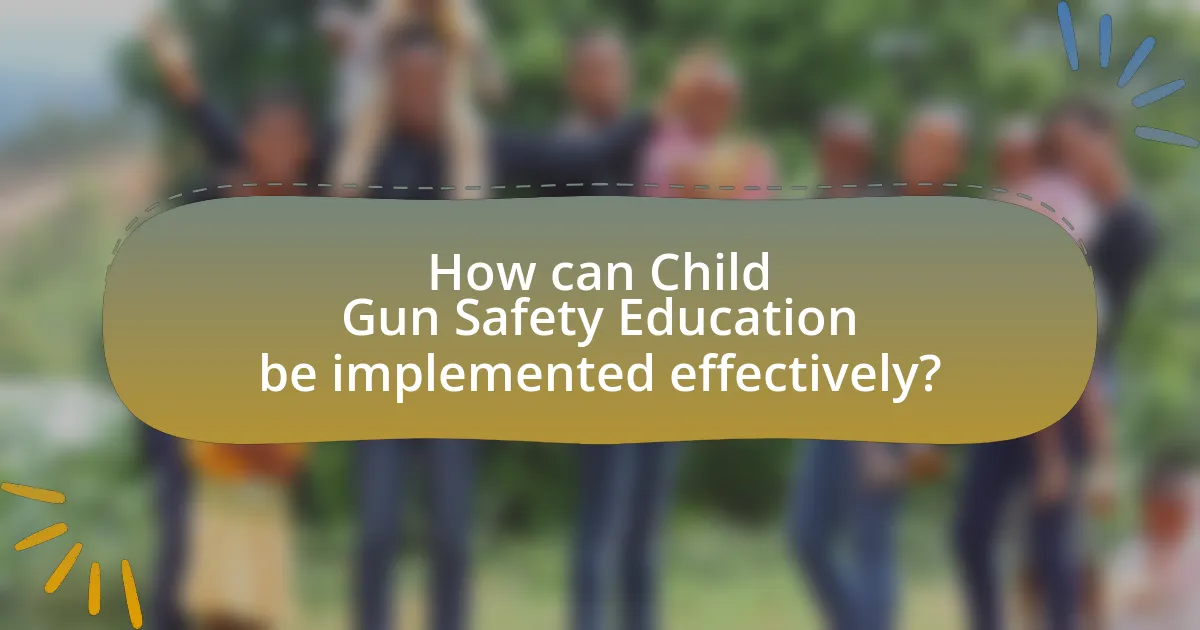
How can Child Gun Safety Education be implemented effectively?
Child Gun Safety Education can be implemented effectively through structured programs that engage children in interactive learning about firearm safety. These programs should include age-appropriate materials that teach children the basics of gun safety, such as recognizing firearms, understanding the importance of not touching them, and reporting any found firearms to an adult.
Research indicates that hands-on training and discussions led by trained educators significantly enhance retention of safety information. For instance, the National Shooting Sports Foundation emphasizes the effectiveness of programs like Eddie Eagle GunSafe, which has reached millions of children with its safety message. Additionally, involving parents in the education process ensures that safety practices are reinforced at home, creating a comprehensive approach to gun safety education.
What resources are available for parents and educators?
Resources available for parents and educators regarding child gun safety education include educational programs, online courses, and community workshops. Organizations such as the National Rifle Association (NRA) and the Eddie Eagle GunSafe Program provide structured curricula designed to teach children about gun safety. Additionally, the American Academy of Pediatrics offers guidelines and resources for parents to discuss gun safety with their children effectively. These resources are validated by research indicating that early education on gun safety significantly reduces the risk of firearm-related accidents among children.
Which organizations provide training and materials for gun safety education?
Organizations that provide training and materials for gun safety education include the National Rifle Association (NRA), the Eddie Eagle GunSafe Program, and the National Shooting Sports Foundation (NSSF). The NRA offers a variety of courses and resources aimed at promoting safe firearm handling and storage. The Eddie Eagle GunSafe Program focuses specifically on teaching children about gun safety through educational materials and presentations. The NSSF provides resources and training aimed at both consumers and industry professionals to enhance gun safety awareness. These organizations are recognized for their commitment to promoting responsible gun ownership and safety education.
How can schools incorporate gun safety education into their curriculum?
Schools can incorporate gun safety education into their curriculum by integrating structured programs that teach students about the safe handling and storage of firearms. These programs can include age-appropriate lessons, interactive workshops, and partnerships with local law enforcement or gun safety organizations. For instance, the National Rifle Association’s Eddie Eagle GunSafe Program provides resources for educators to teach children about gun safety in a non-threatening manner. Research indicates that early education on gun safety can significantly reduce accidental shootings among children, highlighting the importance of such initiatives in schools.
What challenges exist in promoting Child Gun Safety Education?
Promoting Child Gun Safety Education faces several challenges, primarily stemming from cultural attitudes towards firearms, lack of funding, and insufficient training resources. Cultural attitudes often prioritize gun ownership rights over safety education, leading to resistance from parents and communities who may view such education as unnecessary or intrusive. Additionally, funding for educational programs is often limited, resulting in inadequate outreach and resources to effectively teach children about gun safety. Furthermore, there is a scarcity of trained educators who can deliver these programs, which diminishes the overall effectiveness of safety education initiatives. These factors collectively hinder the widespread adoption and implementation of Child Gun Safety Education, ultimately impacting children’s safety.
How do cultural attitudes towards guns affect education efforts?
Cultural attitudes towards guns significantly influence education efforts related to gun safety. In cultures where gun ownership is viewed positively, educational initiatives may focus on responsible gun handling and safety practices, often integrating these topics into school curricula or community programs. Conversely, in cultures that perceive guns negatively, education efforts may emphasize the dangers of firearms and advocate for stricter regulations, potentially limiting discussions on safe usage. For instance, a study by the American Academy of Pediatrics highlights that communities with strong pro-gun sentiments often have more comprehensive gun safety education programs, reflecting their acceptance of firearms as part of daily life. This dynamic illustrates how cultural perspectives shape the content and approach of educational efforts surrounding gun safety.
What misconceptions about gun safety hinder effective education?
Misconceptions about gun safety that hinder effective education include the belief that gun safety is solely the responsibility of gun owners and that children cannot understand gun safety principles. This perspective undermines the importance of comprehensive education for all children, regardless of their household’s gun ownership status. Research indicates that children as young as four can grasp basic safety concepts when taught appropriately, highlighting the need for inclusive educational programs. Additionally, the misconception that gun safety education promotes gun use rather than prevention can deter parents from engaging in these discussions, ultimately limiting children’s awareness and preparedness in potentially dangerous situations.
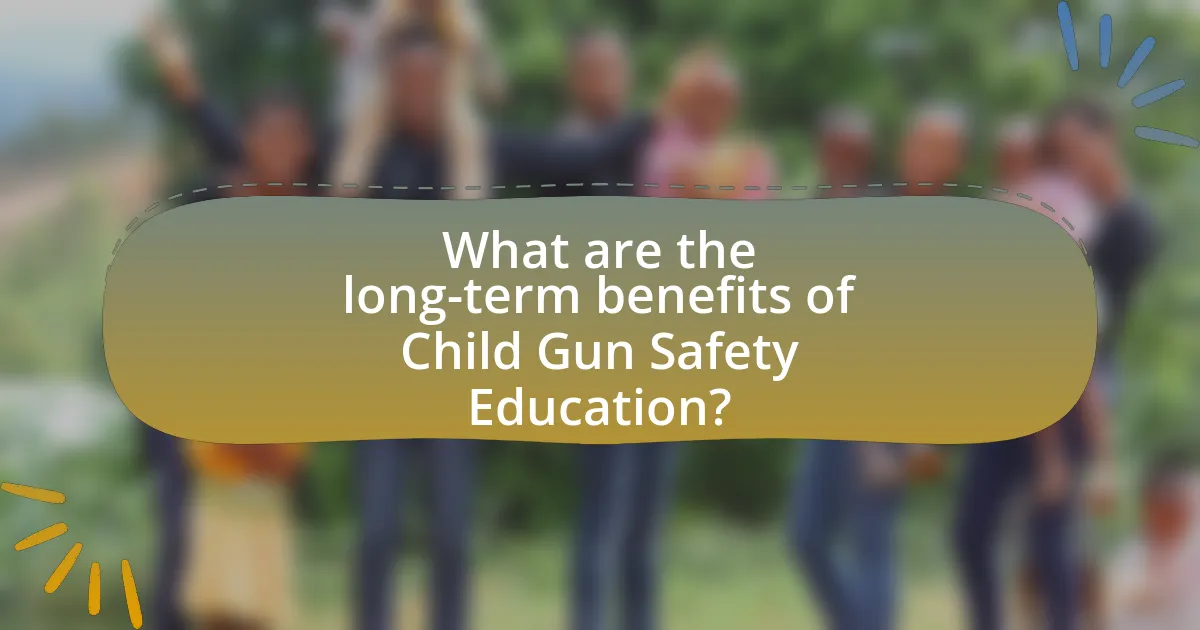
What are the long-term benefits of Child Gun Safety Education?
Child Gun Safety Education provides long-term benefits by significantly reducing the risk of firearm-related accidents among children. Research indicates that children who receive gun safety education are more likely to understand the dangers of firearms and how to handle them responsibly. For instance, a study published in the Journal of Pediatrics found that children who participated in structured gun safety programs demonstrated a 70% decrease in unsafe behaviors around firearms compared to those who did not receive such education. This education fosters a culture of safety, encouraging children to communicate openly about firearms and seek adult assistance when encountering guns. Ultimately, these long-term benefits contribute to a safer environment for children, reducing the incidence of accidental shootings and promoting responsible gun ownership within families.
How does Child Gun Safety Education impact children’s behavior around firearms?
Child Gun Safety Education significantly improves children’s behavior around firearms by instilling knowledge and awareness about the dangers associated with guns. Research indicates that children who receive structured gun safety education are less likely to engage in risky behaviors, such as handling firearms unsupervised. A study published in the journal “Pediatrics” found that children who participated in gun safety programs demonstrated a 70% reduction in the likelihood of mishandling firearms compared to those who did not receive such education. This evidence underscores the effectiveness of educational interventions in promoting safer behaviors among children in environments where firearms are present.
What evidence supports the effectiveness of gun safety education in reducing accidents?
Gun safety education effectively reduces accidents, as evidenced by multiple studies showing significant decreases in firearm-related injuries among children. For instance, a study published in the journal “Pediatrics” by researchers at the University of Washington found that children who participated in gun safety programs were 73% less likely to engage in unsafe behaviors around firearms. Additionally, the National Shooting Sports Foundation reported that states with mandatory gun safety education saw a 40% reduction in unintentional firearm deaths among children. These statistics demonstrate a clear correlation between structured gun safety education and a decrease in firearm accidents.
How can Child Gun Safety Education contribute to community safety?
Child Gun Safety Education can significantly enhance community safety by reducing the risk of accidental shootings involving children. When children are educated about the dangers of firearms and taught safe handling practices, they are less likely to engage in risky behaviors that could lead to tragic incidents. For instance, a study published in the journal “Pediatrics” found that communities with comprehensive gun safety education programs experienced a 30% decrease in unintentional firearm injuries among children. This evidence demonstrates that effective education can lead to safer environments by empowering children with knowledge and skills to avoid dangerous situations involving guns.
What practical tips can parents use to reinforce gun safety at home?
Parents can reinforce gun safety at home by implementing strict storage practices, such as using gun safes or lockboxes to securely store firearms and ammunition. This method significantly reduces the risk of unauthorized access, particularly by children, as studies indicate that 1.7 million children live in homes with unlocked guns. Additionally, parents should engage in open discussions about gun safety, teaching children the importance of not touching firearms and reporting any found weapons to an adult. Regularly practicing safety drills, such as the “Stop, Don’t Touch, Run Away, Tell a Grown-Up” rule, can further instill these safety principles. By combining secure storage with education and practice, parents can effectively minimize the risks associated with firearms in the home.
How can parents create a safe environment for children regarding firearms?
Parents can create a safe environment for children regarding firearms by securely storing firearms in locked cabinets or safes and ensuring that ammunition is stored separately. Research indicates that proper storage reduces the risk of accidental shootings; for instance, a study published in the journal “Pediatrics” found that homes with locked firearms had a significantly lower incidence of unintentional firearm injuries among children. Additionally, parents should engage in open conversations about gun safety, educating children on the dangers of firearms and the importance of reporting any found weapons to an adult. This proactive approach fosters awareness and responsibility, further enhancing safety.
What ongoing conversations should parents have with their children about gun safety?
Parents should have ongoing conversations with their children about the importance of gun safety, including how to recognize firearms, the dangers associated with them, and the appropriate actions to take if they encounter a gun. These discussions should emphasize that children should never touch a gun and should immediately inform an adult if they see one. Research indicates that children who receive consistent education about gun safety are less likely to engage in risky behaviors around firearms. For instance, a study published in the journal “Pediatrics” found that children who were educated about gun safety were significantly less likely to handle guns unsafely.
